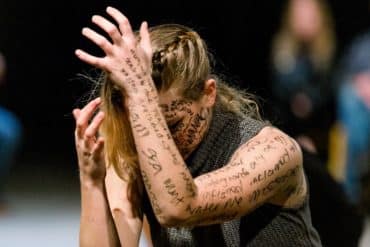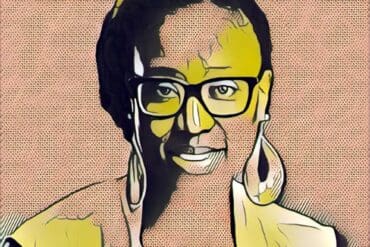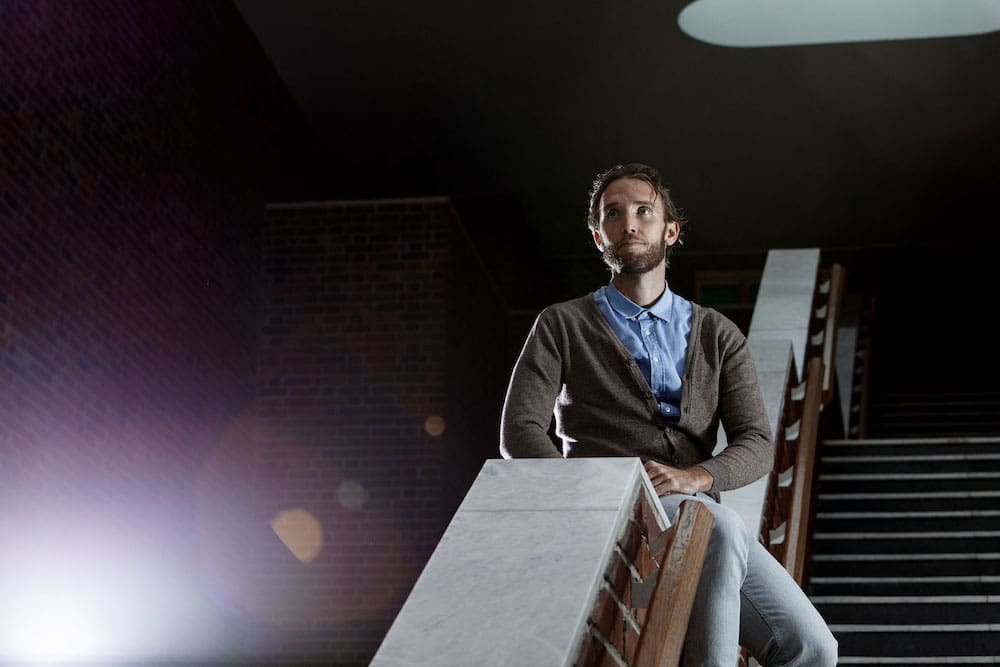Why Is Sign Language an Important Part of Identity Development for a Deaf Child?
This brief essay and video introduce an autoethnographic study of my life as a deaf child in Finland using sign language, titled I Sign, Therefore I Am. I suffered challenging psychiatric problems during puberty as a consequence of an unawareness of my language identity and a lack of social-emotional skills.

I Sign, Therefore I Am
I was born in the 80s as a deaf child into a hearing family. All my relatives were also hearing. My family received very little information about sign language from the hearing center. My parents wondered what kind of language environment I should be brought up in. To some extent, my parents received some sign language education, but the environment in which I grew up was not known about sign language. My parents were very interested in sign language but attempts to learn more about it were thwarted by various obstacles.
I used very little sign language, on the contrary, mainly Finnish, where my language skills developed well. Finnish was emphasized at school. Although there were other deaf pupils, the teaching method was strongly Finnish. The language used was signed speech, which is not sign language as such, as its grammar is strongly based on spoken language. I had regular hearing tests at the hearing center, where the doctors encouraged me to use Finnish and did not recommend signing.
My childhood was quite comfortable. At school I did well and had friends, but at puberty I started to fall behind. I felt lonely and didn’t know what my identity was. I was ashamed of my deafness. And I got the impression from my environment that deafness was unacceptable. Instead, it would be good to be like the hearing people and use the Finnish language. I adopted this way of thinking, which had a big influence on me during adolescence, as I was all broken and full of wounds inside and I didn’t know who I was.
“I have been deaf from birth. One who cannot hear speech, sweet birdsong, musical melodies or other subtleties of the world of sound. But what else does being deaf imply? How many people consider it or try to find out? Living with one foot in the hearing world and one in the deaf has led me to develop a dualistic identity.” [1]
It wasn’t until years later, at around the age of twenty, that I started to use more Finnish Sign Language and get to know other deaf people. At the same time, I realized that deaf people could succeed in life. These deaf people were role models for me, like Liisa Kauppinen [2], who everyone knew. I searched my heart and realized that sign language would be my emotional language. As I began to sign more and more, I understood myself better. I discovered my identity and my role in society.
As my sign language skills got stronger, my Finnish language skills also improved. This gave me a strong, bilingual identity. At the end of a long process, I am today a very proud sign language user, and Finnish Sign Language is a strong foundation of my identity.
I am concerned about today’s children, their language environment and the development of their identity. Today, the majority of deaf children have their cochlear implants cut and many of them do not sign because sign language education is not provided for their families. I have met many of these families, and parents have expressed concern about the lack of a sign language environment in which to grow up.
“I am concerned about today’s children, their language environment and the development of their identity.”
In Finland, access to sign language education varies widely. Teaching often requires a medical certificate, which is not necessarily available. In addition, municipalities argue about the obligations of teaching arrangements. Serious consequences have arisen. I spoke to a mother who told me that her family had fought fiercely for sign language teaching. The family has also asked for help from various organizations. Still, they have not received sign language education from their hometown.
Today’s society does not understand the importance of sign language, which is still seen as an auxiliary language. It may be introduced when a child with a cochlear implant does not benefit from spoken language. But this is completely the wrong direction. Sign language should be used alongside spoken language right from the start. This would allow the principle of bilingualism to become a reality.
I’ll show you an example of a video (starting at 5.24 min) where I’m a 7-year-old boy myself. You can see what can happens in a situation where a child has no sign language basis for his identity:
“What matters deafness of the ears when the mind hears? The one true deafness, the incurable deafness, is that of the mind.” Victor Hugo, writing to Ferdinand Berthier (25/11/1845)
I’m sure you noticed in the video what it looks like when a child is alone and withdraws from the group. I was in my own world, I didn’t understand what was being discussed in the group, and those times have stayed with me hard. It was painful for me to be in a group where I didn’t understand anything. The same was true for the spoken language, so I was doubly lonely. It felt really bad. It was like being in a closed room with no way out.
The others didn’t understand me, and I didn’t understand them. It took me a long time to get over these difficult phases. And today I see the same phenomena in children. Many of them are alone, perhaps marginalized. Today, the principle of local schools has been strengthened, which means that children with very different sign language skills are scattered in their local schools. Who will take care of the development of their identity? Who will support their families? They should be listened to more and encouraged to use sign language and bilingual education.

“Children must grow up in such a way that they can accept themselves and have linguistic diversity: spoken languages, sign languages, and thus develop in a multilingual and multicultural environment.”
I remember very well from my childhood that children are very sensitive and can sense what is going on in their environment. If adults have a negative attitude towards sign language and do not recommend its use, the child will adopt a similar mindset. The child may then not want to sign. This is what happened to me. My mother would have signed with me, but I told her not to because I was ashamed of sign language. It is very important to give children models of how to appreciate and respond positively to sign language. If parents have to struggle to get sign language lessons, children may become frustrated and no longer want to sign. This can lead to serious problems later in adolescence, as it did for me.
I have written a book about my experiences: I Sign, Therefore I Am. I think that today it would be good to be more aware of the important role that sign language plays in the construction of a child’s identity. We should take into account children’s rights and proceed on their terms.
“My journey has led me through great difficulties to form a cohesive identity as a deaf sign language person, and I am proud of that. In all honesty, on this journey of discovery I have also experienced quite extraordinary moments of joy, elation and euphoria. My attitude towards deafness and sign language has radically changed.” [3]
How can we as adults take better account of them? We adults should also remember that we are role models. We should not forget this. Children must grow up in such a way that they can accept themselves and have linguistic diversity: spoken languages, sign languages, and thus develop in a multilingual and multicultural environment. If they cannot, depression and other mental disorders may result. In the same way that I had to deal with my situation during adolescence. It’s not a matter of play.
I very much hope that we will reflect together on this important issue of identity. Finnish Sign Language and Finland-Swedish Sign Language are minority languages in Finland. If families are denied the opportunity to learn sign language, they may never have access to it again. Finnish and other spoken languages are constantly in abundance, while sign languages are very scarce. It would be good to hold on to what little sign language there is.

Miksi viittomakieli on tärkeä osa kuuron lapsen identiteetin kehitystä?
Tässä lyhyessä esseessä ja videossa esitellään autoetnografinen tutkimus elämästäni viittomakieltä käyttävänä kuurona lapsena Suomessa, otsikolla Viiton –olen olemassa. Kärsin murrosiässä haastavista psykiatrisista ongelmista, jotka johtuivat kielellisen identiteettini tiedostamattomuudesta ja sosiaalis-emotionaalisten taitojen puutteesta.
Viiton – olen olemassa
Synnyin 80-luvulla kuurona kuulevaan perheeseen. Kaikki sukulaiseni olivat myös kuulevia. Perheeni sai hyvin vähän tietoa viittomakielestä kuulokeskuksesta. Vanhempani pohtivat, millaisessa kieliympäristössä minut pitäisi kasvattaa. Jossain määrin vanhempani saivat viittomakielistä opetusta, mutta ympäristö, jossa kasvoin, ei tiennyt viittomakielestä. Vanhempani olivat hyvin kiinnostuneita viittomakielestä, mutta yritykset oppia siitä lisää kariutuivat erilaisiin esteisiin. Käytin viittomakieltä hyvin vähän, päinvastoin lähinnä suomea, jossa kielitaitoni kehittyi hyvin. Koulussa suomea korostettiin. Vaikka siellä oli muitakin kuuroja oppilaita, opetusmenetelmä oli vahvasti suomenkielinen. Kielenä käytettiin viitottua puhetta, joka ei sinänsä ole viittomakieli, sillä sen kielioppi perustuu vahvasti puhuttuun kieleen. Kävin säännöllisesti kuulokokeissa kuulokeskuksessa, jossa lääkärit kannustivat minua käyttämään suomea eivätkä suositelleet viittomakieltä.
Lapsuuteni oli varsin mukava. Koulussa pärjäsin hyvin ja minulla oli ystäviä, mutta murrosiässä aloin jäädä jälkeen. Tunsin itseni yksinäiseksi enkä tiennyt, mikä oli identiteettini. Häpesin kuurouttani. Ja sain ympäristöstäni sen käsityksen, että kuuroutta ei voitu hyväksyä. Sen sijaan olisi hyvä olla kuin kuulevat ihmiset ja käyttää suomen kieltä. Omaksuin tämän ajattelutavan, joka vaikutti minuun suuresti nuoruusvuosina, sillä olin sisältä aivan rikki ja täynnä haavoja enkä tiennyt, kuka olin.
“Olen ollut syntymästäni lähtien kuuro. Hän, joka ei kuule puhetta, linnun somaa laulua, musiikin melodioita eikä muita äänimaailman hienouksia. Moniko tulee ajatelleeksi tai ottaneeksi selvää, mitä muuta kuurous pitää sisällään? Elämä samanaikaisesti sekä kuulevien että kuurojen maailmassa loi alussa pohjaa ikään kuin kahtia jakautuvalle persoonalleni.”
Vasta vuosia myöhemmin, noin parikymppisenä, aloin käyttää enemmän suomalaista viittomakieltä ja tutustua muihin kuuroihin. Samalla tajusin, että kuurot voivat menestyä elämässä. Nämä kuurot olivat minulle roolimalleja, kuten Liisa Kauppinen [2], jonka kaikki tunsivat. Etsin sydäntäni ja tajusin, että viittomakielestä tulisi tunnekieleni. Kun aloin viittoa yhä enemmän ja enemmän, ymmärsin itseäni paremmin. Löysin identiteettini ja roolini yhteiskunnassa.
Kun viittomakielitaitoni vahvistui, myös suomen kielen taitoni parani. Tämä antoi minulle vahvan, kaksikielisen identiteetin. Pitkän prosessin päätteeksi olen nykyään hyvin ylpeä viittomakielen käyttäjä, ja suomalainen viittomakieli on identiteettini vahva perusta.
Olen huolissani nykypäivän lapsista, heidän kieliympäristöstään ja identiteettinsä kehittymisestä. Nykyään suurimmalle osalle kuuroista lapsista on leikattu sisäkorvaistute, ja monet heistä eivät viittoa, koska viittomakielistä opetusta ei järjestetä heidän perheilleen. Olen tavannut monia näistä perheistä, ja vanhemmat ovat ilmaisseet huolensa viittomakielisen kasvuympäristön puuttumisesta.
“Olen huolissani nykypäivän lapsista, heidän kieliympäristöstään ja identiteettinsä kehittymisestä.”
Suomessa viittomakielisen opetuksen saatavuus vaihtelee suuresti. Opetus edellyttää usein lääkärintodistusta, jota ei välttämättä ole saatavilla. Lisäksi kunnat kiistelevät opetusjärjestelyjen velvoitteista. Tästä on aiheutunut vakavia seurauksia. Juttelin erään äidin kanssa, joka kertoi, että hänen perheensä oli taistellut kiivaasti viittomakielen opetuksen puolesta. Perhe on myös pyytänyt apua eri järjestöiltä. Silti he eivät ole saaneet viittomakielen opetusta kotikaupungistaan.
Nyky-yhteiskunta ei ymmärrä viittomakielen merkitystä, sillä sitä pidetään edelleen apukielenä. Se voidaan ottaa käyttöön, kun sisäkorvaistutteen saanut lapsi ei hyödy puhutusta kielestä. Tämä on kuitenkin täysin väärä suunta. Viittomakieltä pitäisi käyttää puhutun kielen rinnalla alusta alkaen. Näin kaksikielisyyden periaate voisi toteutua.
Näytän esimerkkinä videon (alkaa 5.24 min), jossa olen itse 7-vuotias poika. Näette, mitä voi tapahtua tilanteessa, jossa lapsella ei ole viittomakielistä perustaa identiteetilleen:
“What matters deafness of the ears when the mind hears? The one true deafness,
the incurable deafness, is that of the mind.” Victor Hugo, writing to Ferdinand
Berthier (25/11/1845)
Huomasitte varmasti videolta, miltä näyttää, kun lapsi on yksin ja vetäytyy ryhmästä. Olin omassa maailmassani, en ymmärtänyt, mistä ryhmässä puhuttiin, ja nuo hetket ovat jääneet kovasti mieleeni. Minulle oli tuskallista olla ryhmässä, jossa en ymmärtänyt mitään. Sama päti puhuttuun kieleen, joten olin kaksin verroin yksinäinen. Se tuntui todella pahalta. Se oli kuin olisi ollut suljetussa huoneessa ilman ulospääsyä.
Muut eivät ymmärtäneet minua, enkä minä ymmärtänyt heitä. Kesti kauan päästä ylinäistä vaikeista vaiheista. Ja nykyään näen samoja ilmiöitä lapsissa. Monet heistä ovat yksin, ehkä syrjäytyneitä. Nykyään lähikouluperiaatetta on vahvistettu, mikä tarkoittaa, että lapset, joilla on hyvin erilainen viittomakielitaito, ovat hajallaan lähikouluissaan. Kuka huolehtii heidän identiteettinsä kehittymisestä? Kuka tukee heidän perheitään? Heitä pitäisi kuunnella enemmän ja rohkaista viittomakielen ja kaksikielisen opetuksen käyttöön.
Muistan hyvin lapsuudestani, että lapset ovat hyvin herkkiä ja aistivat, mitä heidän ympäristössään tapahtuu. Jos aikuiset suhtautuvat viittomakieleen kielteisesti eivätkä suosittele sen käyttöä, lapsi omaksuu samanlaisen ajattelutavan. Silloin lapsi ei ehkä halua viittoa. Minulle kävi juuri näin. Äitini olisi viittonut kanssani, mutta kielsin häntä, koska häpesin viittomakieltä. On hyvin tärkeää antaa lapsille malleja siitä, miten he voivat arvostaa viittomakieltä ja reagoida siihen myönteisesti. Jos vanhemmat joutuvat ponnistelemaan saadakseen viittomakielen opetusta,lapset saattavat turhautua eivätkä enää halua viittoa. Tämä voi johtaa vakaviin ongelmiin myöhemmin nuoruusiässä, kuten minulle kävi.
“Lasten on kasvettava niin, että he voivat hyväksyä itsensä ja että heillä on
kielellistä monimuotoisuutta: puhuttuja kieliä, viittomakieliä, ja siten kehittyä
monikielisessä ja monikulttuurisessa ympäristössä.”
Olen kirjoittanut kirjan kokemuksistani: Viiton – olen olemassa. Mielestäni nykyään olisi hyvä olla tietoisempi siitä tärkeästä roolista, joka viittomakielellä on lapsen identiteetin rakentumisessa. Meidän pitäisi ottaa huomioon lasten oikeudet ja toimia heidän ehdoillaan.
Miten me aikuiset voimme ottaa heidät paremmin huomioon? Meidän aikuisten olisi myös muistettava, että olemme roolimalleja. Meidän ei pidä unohtaa tätä. Lasten on kasvettava siten, että he voivat hyväksyä itsensä ja kielellisen monimuotoisuuden: puhutut kielet, viittomakielet, ja siten kehittyä monikielisessä ja monikulttuurisessa ympäristössä. Jos he eivät pysty siihen, seurauksena voi olla masennusta ja muita mielenterveyshäiriöitä. Samalla tavalla kuin minä jouduin käsittelemään omaa tilannettani teini-iässä. Tämä ei ole leikin asia.
Toivon kovasti, että pohdimme yhdessä tätä tärkeää identiteettikysymystä. Suomalainen viittomakieli ja suomenruotsalainen viittomakieli ovat Suomessa vähemmistökieliä. Jos perheiltä evätään mahdollisuus opetella viittomakieltä, he eivät ehkä enää koskaan pääse käyttämään sitä. Suomea ja muita puhuttuja kieliä on jatkuvasti runsaasti, kun taas viittomakieliä on hyvin vähän. Olisi hyvä pitää kiinni siitä vähäisestä viittomakielestä, mitä on tarjolla.
“Matkani on johtanut minut suurten vaikeuksien kautta muodostamaan yhtenäisen identiteetin kuurona viittomakielisenä, ja olen siitä ylpeä. Rehellisesti sanottuna olen tällä löytöretkellä kokenut myös aivan poikkeuksellisia ilon, riemun ja euforian hetkiä. Suhtautumiseni kuurouteen ja viittomakieleen on muuttunut radikaalisti.” [3]
Notes
[1] Salonen, J. (2021). I sign, therefore I am. [Viiton – olen olemassa.] Books on Demand.
[2] The United Nations Prize in the Field of Human Rights, awarded in December 2013 to Liisa Kauppinen who was a former Executive Director of Finnish Association of the Deaf and President of the World Federation of the Deaf. YK:n ihmisoikeuspalkinto, joka myönnettiin joulukuussa 2013 Liisa Kauppiselle, joka oli Suomen Kuurojen Liiton entinen toiminnanjohtaja ja Kuurojen Maailmanliiton presidentti.
[3] Salonen, J. (2021). I sign, therefore I am. [Viiton – olen olemassa.] Books on Demand.
Credits
Photos by Jussi Rinta-Hoiska
Learn More
New to autoethnography? Visit What Is Autoethnography? How Can I Learn More? to learn about autoethnographic writing and expressive arts. Interested in contributing? Then, view our editorial board’s What Do Editors Look for When Reviewing Evocative Autoethnographic Work?. Accordingly, check out our Submissions page. View Our Team in order to learn about our editorial board. Please see our Work with Us page to learn about volunteering at The AutoEthnographer. Visit Scholarships to learn about our annual student scholarship competition.
Juhana Salonen is a Deaf sign language user who has specialized in identity through an autoethnographic approach. Salonen works as a project researcher at the University of Jyväskylä. He has written an autobiographical book I Sign, Therefore I Am. The homepage of the book: https://juhanasalonen.com. Facebook: @Isignthereforeiam; X/Twitter: @JuhanaSalonen; Email: juhanas at gmail dot com











